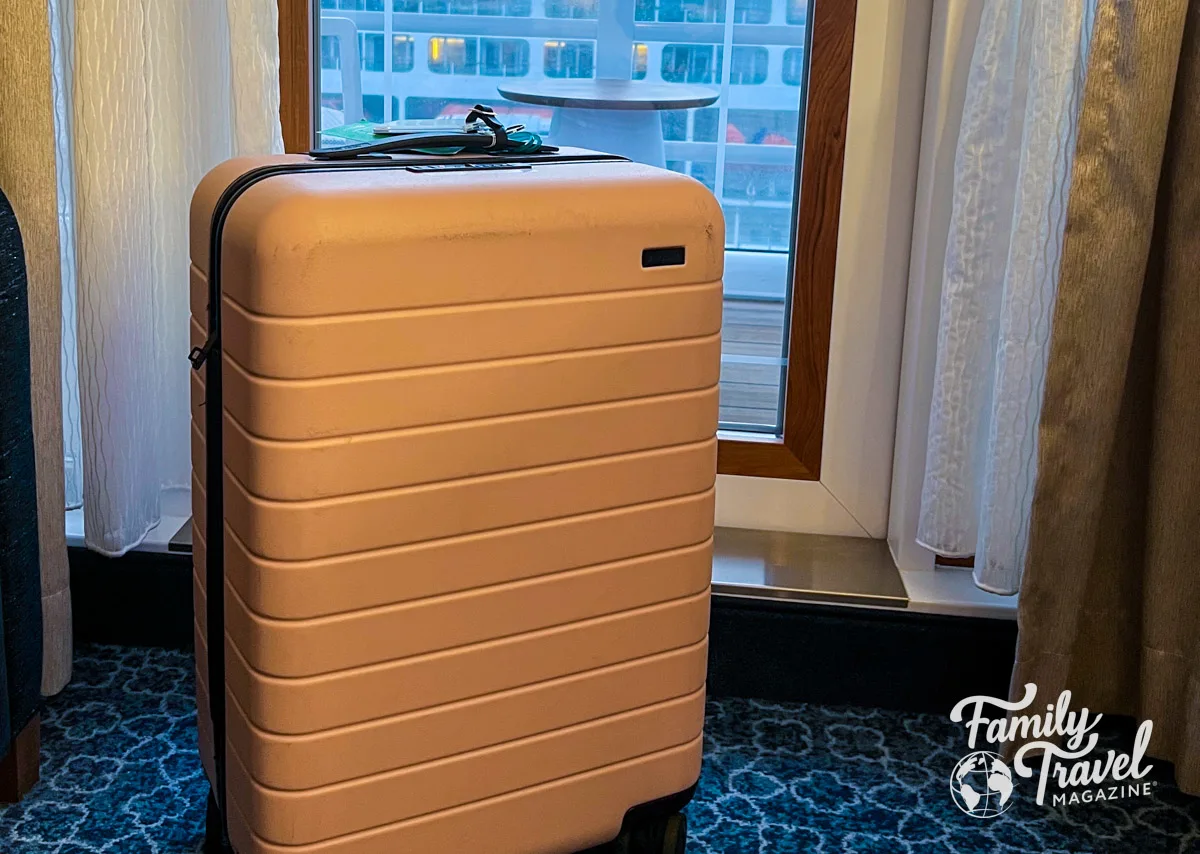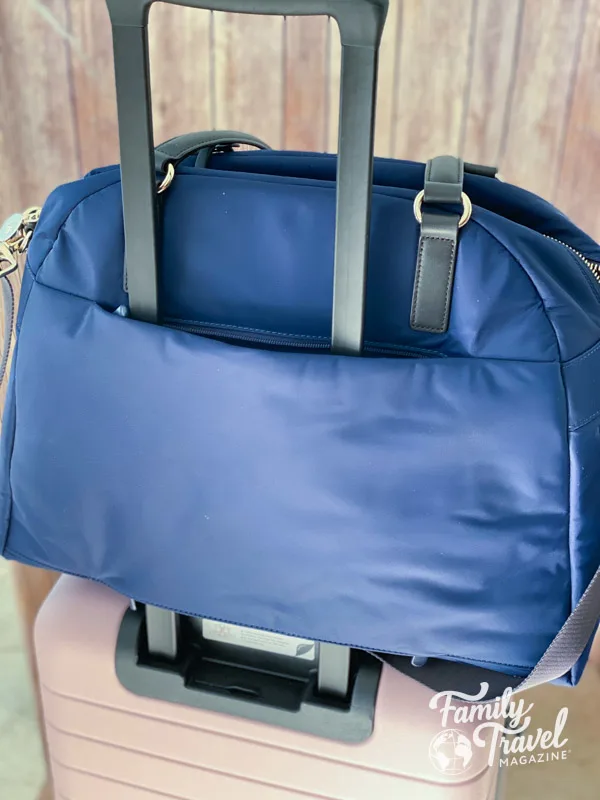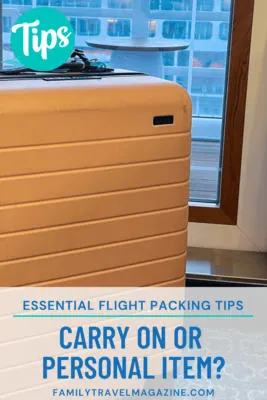Packing for vacation is always a challenge, especially when flying for your family vacation. There are only so many things you can put in your bags, and with baggage fees, you’ll need to be an efficient packer.
Once airlines started charging for checked bags, many travelers started using carry-on bags more. However, now those many also come with an added fee. In addition, as bags are getting lost and delayed more frequently (three times for us in the last eighteen months!), travelers are forgoing the checked bags.
Wondered how things work with a carry on vs. personal item? The requirements for these start with the FAA and TSA, although your airline (and even the specific aircraft you are on) can dictate the size requirement. Here are some recommendations for traveling with a carry-on vs. a personal item.
This post contains affiliate links. A purchase and/or click through one of these links may result in a commission paid to us at no additional cost to you. All opinions are my own.

Carry On vs. Personal Item: Essential Flight Packing Tips
Regulations for Carry-On Bags
The carry-on vs personal item rules and regulations can always change, so it’s essential to check with your airline before packing. Remember that your allowance may vary depending on the type of ticket you’ve purchased. While it may seem like you are saving money on a lower-price ticket, sometimes it’s not worth it.
Budget airlines especially have rules around carry-on baggage. However, the major airlines often offer basic economy tickets (a subset of economy class) that do not include carry-ons or checked bags.
If carry-ons are included in the fare, travelers are typically allowed one carry-on bag and one personal item. A personal item is typically a briefcase, laptop bag, or handbag. However, sometimes ,a small backpack, camera bag, and duffel bag can also be considered personal items.
While the regulations may vary, the important thing is that it must fit under the seat in front of you (called underseat luggage). Check directly with your airline to find the size guidelines for personal items.
Diaper bags, breast pumps, duty-free items (a specific size limit may be applied), and assistive devices (although mobility devices may need to be checked) do not typically count toward your personal item allowance.
However, that may vary by airline, especially for lap infants. For instance, on Alaska Airlines, lap infants do not get a separate diaper bag allowance. Check in advance with your airline.
Traveling with sports equipment? Some items are allowed in carry-on bags, while others need to be checked. You’ll need to verify directly with your airline to see the rules for your specific equipment. It’s also essential that you work directly with the airline if you plan to carry on a pet carrier – you’ll have to pay extra, and it will be subject to availability. You’ll also have to follow specific size guidance,e which may vary by airline.
Belt bags and fanny packs have become increasingly popular, but know that these will be considered one of your bags. While you may want to wear one of these bags around the airport, you’ll need to tuck it into your personal item or carry-on bag if you have one in addition to these two allowed bags. I usually bring a small purse that I tuck into a larger duffel.
Your carry-on bag can go into the luggage compartment above your seat. Even though airlines have started charging an extra fee for carry-ons (or not allowing them at all for certain fares), the space is still limited. You may have to check your bag if you are among the last to board the plane.
In addition, small regional jets often have small overhead bins. In that case, most roller bag carry-on bags won’t fit in the overhead compartment and must be gate-checked.
Airline Charges for Carry-Ons
First, airlines started charging for bags, but now some also charge for carry-on bags. If you are a very light packer, you can save money on airfare, otherwise, you’ll need to consider these added costs when booking.
Here are some of the charges to expect. Note that we do not guarantee the accuracy of this data – you’ll need to check directly with your airline. If there’s always a fee for carry-on bags (for Frontier and Spirit, for instance), you can often save money by purchasing that in advance.
On other airlines, if you are purchasing a basic fare, you will most likely not be able to pay to bring a carry-on bag.
Rules for Major US Airlines
Each airline will have specific rules around the maximum size allowed for your carry-on item. While all airlines have sizer bins at the airport where you can measure your carry on luggage, often you’ll want to check your carry-on size before leaving home.
Weight may also be important. Some airlines have a maximum weight for carry-on bags. Even if they don’t, you’ll need to lift it over your head. Often a flight attendant will be unable to assist.
Below is a table showing a general overview of the maximum dimensions allowed on popular domestic airlines for domestic flights (international flights may have different rules). This is for informational purposes only, and size restrictions should be checked with your airline directly before packing.
Keep in mind that weight limits may also apply. We do not guarantee the accuracy of this information – check the airline’s website.
| Airline | Carry-On Size |
| Delta Airlines | 22” x 14” x 9” (not over 45 linear inches) |
| American Airlines | 22” x 14” x 9” |
| United Airlines | 22” x 14” x 9” |
| Frontier Airlines | 10″D x 16″W x 24″H, 35 lbs |
| Spirit Airlines | 22 x 18 x 10 inches |
| Jetblue Airlines | 22” x 14” x 9” |
| Southwest Airlines | 24” (L) + 16” (W) + 10” (H) |
Some airlines also have sizing rules for personal items. Check directly with their website.
Rules For What Can Be Carried On
In addition to the sizing rules, there are other regulations regarding which items can be placed in carry-on bags. Liquids larger than 3.4 ozs cannot be carried on and must go into your checked bag, and other items are also restricted. This list from the TSA is very helpful and lists various popular items you may consider packing.
What to Put in Carry On Vs. Personal Item
When packing your carry-on and personal items, you’ll need to decide what goes into your personal item vs carry-on. You’ll have less room in the personal item, but the things in that bag will be easier to access in flight.
Even if you have a carry-on bag included with your airfare, you may still be separated from your bag. There may be no more room on the flight, you may be on a smaller plane with smaller overhead bin space, or your bag may be in front or behind your seats. Therefore, it’s always a great idea to ensure any important items are in your personal item.
This would include medications, valuable items, passports, other travel documents, keys, and anything you plan to use during your flight (like a book or laptop computer). If traveling with young kids, you’ll also want to ensure you have their essential toys, snacks, medications, and diaper supplies in your personal items.
If your carry-on bag has to be checked, you’ll need to ensure there are no prohibited items in checked bags. Typically, the biggest issue is with lithium batteries, but you’ll want to look at the prohibited list to learn about all of the items.

Bag Recommendations
You’ll want to be strategic about purchasing and packing your carry-on bag. One of the benefits of checking your luggage is that you won’t have to carry it around the airport – especially if you have a connection.
While carry-on luggage is convenient, you do have to be responsible for it for your entire travel time. I have a few favorite carry-on bags – the best carry-on, however, will be the one that works for your travels.
Away bags are extremely popular and come in beautiful colors. They have a hard shell and spinner wheels, making them very easy to roll. (Use this link for a $20 discount Away code).
Another carry-on bag that I love is the Hideo Wakamatsu Tarpaulin bag. We have both the carry on and the full-sized luggage. These soft-sided bags are a great piece of luggage – they fit a ton of stuff and are also water-resistant. They are lightweight, so you can put even more things in them.
There are various duffles that are good as carry-ons or underseat luggage. Lo & Sons and Dagne Dover (in addition to Away) both make duffle bags and backpacks that are designed specifically for travel (use this URL for $20 off your first Dagne Dover purchase of $100 or more).
You can see our favorite personal items in this link.

More Packing Tips Resources: Looking for more packing tips and recommendations? Here are all of our posts including packing lists, product recommendations, and ideas for specific trips.